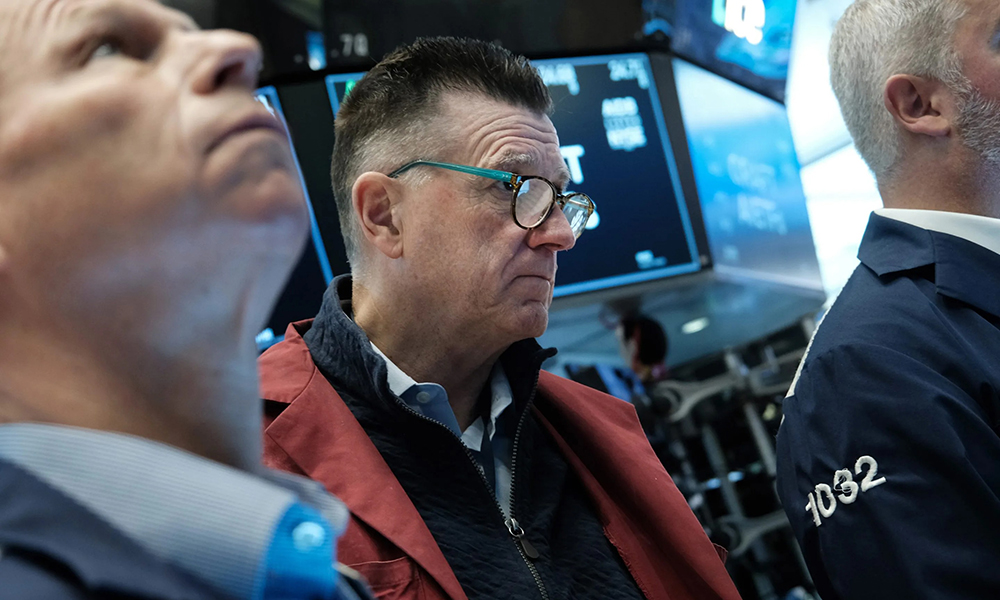知名经济学家称美国已经陷入经济衰退

一年多以来,许多人都担心美国经济陷入经济衰退,因此这次假设的经济衰退,可能已经成为史上被最广泛预测的一次衰退。经济衰退为什么似乎无法避免?可能是美国自去年3月以来的连续10次加息,后续的房地产市场低迷,或者2022年各行各业的大规模裁员和长期股市动荡,使美国经济尤其是科技行业濒临衰退。罪魁祸首也可能是所有这些原因叠加(再加上通货膨胀)。但现在,一位知名经济学家却表示,我们不必为即将发生经济衰退而忧心忡忡,因为经济衰退已经发生,只是没有人注意而已。他表示,我们观察的角度是错误的。
罗森伯格研究公司(Rosenberg Research)的创始人、前华尔街首席经济学家大卫·罗森伯格在周四发推文称:“没有人讨论今天发布的实际GDI数据。”他所说的是当天发布的国内总收入(GDI)数据。罗森伯格曾在Gluskin Sheff和美林(Merrill Lynch)等华尔街机构任职近二十年。
没有人讨论今天发布的实际GDI数据。实际GDI去年第四季度下降了3.3%,今年第一季度下降了2.3%(按年率季节调整后)。将GDI与GDP平均计算,美国经济在过去5个季度,已经连续四个季度萎缩!经济衰退已经发生,只是没有人注意而已。pic.twitter.com/uFm5TZnY9F
—— 大卫·罗森伯格(@EconguyRosie)2023年5月25日
2023年第一季度国内总收入下降2.3%,2022年最后一个季度下降了3.3%。这是自新冠疫情爆发以来最严重的连续两个季度下降,而连续两个季度下降就是经济学家们所说的“技术性衰退”。
另一方面,从国内生产总值(GDP)数据来看,今年第一季度美国经济增长1.3%,已经避免了衰退。GDI和GDP是衡量经济表现的关键指标。罗森伯格认为,所有人都忽视了一个关键数据点所传达出来的信息。
罗森伯格写道:“将GDI与GDP平均计算,美国经济在过去5个季度,已经连续4个季度萎缩!经济衰退已经发生,只是没有人注意而已。”
GDI和GDP两个指标息息相关,它们所衡量的对象几乎相同,但并未完全一样。经济分析局(Bureau of Economic Analysis)认为,GDI衡量的是构成GDP的所有要素的销售收入和生产成本,而GDP通常被认为是更可靠的估算。悲观的GDI数据表明,虽然美国持续加息和收紧可用信贷额度,但高通胀依旧导致经济增速放缓。
情况有多悲观?
但金融市场如何(或是否)将潜在的经济衰退考虑在内,目前仍没有定论。今年前几个月的强劲数据,包括低失业率、稳健的消费者支出和缓慢的GDP增长数据等,使投资者们纷纷期待,即使发生经济衰退,也应该是适度衰退。
几个月来,罗森伯格一直对美国经济持悲观态度,他强调金融市场对于经济衰退的看法存在脱节。他在周四发布的推文中指出,标普500指数中的关键行业,如交通运输和非必需消费品等,都与经济健康息息相关,而这些行业的交易水平严重下降。罗森伯格认为,这体现出来的经济衰退,与历史上发生过的许多次经济衰退类似,例如2008年金融危机期间。自今年年初以来,标普500指数整体上涨9.64%。
但即使在今年早些时候,这位华尔街资深经济学家也并不完全相信当时的积极论调。2月,他发推文称,美国经济“不着陆”的观点是不现实的。所谓“不着陆”的情况是指加息未引发经济衰退,同时通胀率依旧居高不下,但经济维持增长。
他在推文中写道:“‘不着陆’的论调是自2008年的‘全球脱钩’以来,华尔街经济学家们兜售的最大骗局。”他所说的“全球脱钩”是指新兴经济体和发达国家的商业周期日益脱节的一种观点。
罗森伯格在今年早些时候就曾警告美国会陷入经济衰退,他表示,到美联储暂停加息时,标普500指数可能下跌30%。
罗森伯格对MarketWatch表示:“经济衰退即将发生。”
他提到经济受到的长期冲击时表示:“市场通常会在经济衰退的后期,即进入美联储的宽松周期后触底。”
如果其他长期指标可信,例如铜价等,我们或许比投资者们预期的更接近经济衰退。
经纪公司StoneX的基本金属分析师娜塔莉·斯科特-格雷向《金融时报》谈论铜价时表示:“这是我们看到的第一个切实证据,表明西方国家的需求受影响的严重程度超出预期。”作为全球各行各业使用最广泛的金属之一,铜交易量体现了需求情况。
另外一个经济衰退的指标来自公司营收。据彭博社报道,标普500公司的利润较前一年预计平均下降约3.7%,虽然大多数公司的收益都超出了预期,但这算不上巨大的胜利,因为分析师已经下调了指导。(财富中文网)
翻译:刘进龙
审校:汪皓
一年多以来,许多人都担心美国经济陷入经济衰退,因此这次假设的经济衰退,可能已经成为史上被最广泛预测的一次衰退。经济衰退为什么似乎无法避免?可能是美国自去年3月以来的连续10次加息,后续的房地产市场低迷,或者2022年各行各业的大规模裁员和长期股市动荡,使美国经济尤其是科技行业濒临衰退。罪魁祸首也可能是所有这些原因叠加(再加上通货膨胀)。但现在,一位知名经济学家却表示,我们不必为即将发生经济衰退而忧心忡忡,因为经济衰退已经发生,只是没有人注意而已。他表示,我们观察的角度是错误的。
罗森伯格研究公司(Rosenberg Research)的创始人、前华尔街首席经济学家大卫·罗森伯格在周四发推文称:“没有人讨论今天发布的实际GDI数据。”他所说的是当天发布的国内总收入(GDI)数据。罗森伯格曾在Gluskin Sheff和美林(Merrill Lynch)等华尔街机构任职近二十年。
没有人讨论今天发布的实际GDI数据。实际GDI去年第四季度下降了3.3%,今年第一季度下降了2.3%(按年率季节调整后)。将GDI与GDP平均计算,美国经济在过去5个季度,已经连续四个季度萎缩!经济衰退已经发生,只是没有人注意而已。pic.twitter.com/uFm5TZnY9F
—— 大卫·罗森伯格(@EconguyRosie)2023年5月25日
2023年第一季度国内总收入下降2.3%,2022年最后一个季度下降了3.3%。这是自新冠疫情爆发以来最严重的连续两个季度下降,而连续两个季度下降就是经济学家们所说的“技术性衰退”。
另一方面,从国内生产总值(GDP)数据来看,今年第一季度美国经济增长1.3%,已经避免了衰退。GDI和GDP是衡量经济表现的关键指标。罗森伯格认为,所有人都忽视了一个关键数据点所传达出来的信息。
罗森伯格写道:“将GDI与GDP平均计算,美国经济在过去5个季度,已经连续4个季度萎缩!经济衰退已经发生,只是没有人注意而已。”
GDI和GDP两个指标息息相关,它们所衡量的对象几乎相同,但并未完全一样。经济分析局(Bureau of Economic Analysis)认为,GDI衡量的是构成GDP的所有要素的销售收入和生产成本,而GDP通常被认为是更可靠的估算。悲观的GDI数据表明,虽然美国持续加息和收紧可用信贷额度,但高通胀依旧导致经济增速放缓。
情况有多悲观?
但金融市场如何(或是否)将潜在的经济衰退考虑在内,目前仍没有定论。今年前几个月的强劲数据,包括低失业率、稳健的消费者支出和缓慢的GDP增长数据等,使投资者们纷纷期待,即使发生经济衰退,也应该是适度衰退。
几个月来,罗森伯格一直对美国经济持悲观态度,他强调金融市场对于经济衰退的看法存在脱节。他在周四发布的推文中指出,标普500指数中的关键行业,如交通运输和非必需消费品等,都与经济健康息息相关,而这些行业的交易水平严重下降。罗森伯格认为,这体现出来的经济衰退,与历史上发生过的许多次经济衰退类似,例如2008年金融危机期间。自今年年初以来,标普500指数整体上涨9.64%。
但即使在今年早些时候,这位华尔街资深经济学家也并不完全相信当时的积极论调。2月,他发推文称,美国经济“不着陆”的观点是不现实的。所谓“不着陆”的情况是指加息未引发经济衰退,同时通胀率依旧居高不下,但经济维持增长。
他在推文中写道:“‘不着陆’的论调是自2008年的‘全球脱钩’以来,华尔街经济学家们兜售的最大骗局。”他所说的“全球脱钩”是指新兴经济体和发达国家的商业周期日益脱节的一种观点。
罗森伯格在今年早些时候就曾警告美国会陷入经济衰退,他表示,到美联储暂停加息时,标普500指数可能下跌30%。
罗森伯格对MarketWatch表示:“经济衰退即将发生。”
他提到经济受到的长期冲击时表示:“市场通常会在经济衰退的后期,即进入美联储的宽松周期后触底。”
如果其他长期指标可信,例如铜价等,我们或许比投资者们预期的更接近经济衰退。
经纪公司StoneX的基本金属分析师娜塔莉·斯科特-格雷向《金融时报》谈论铜价时表示:“这是我们看到的第一个切实证据,表明西方国家的需求受影响的严重程度超出预期。”作为全球各行各业使用最广泛的金属之一,铜交易量体现了需求情况。
另外一个经济衰退的指标来自公司营收。据彭博社报道,标普500公司的利润较前一年预计平均下降约3.7%,虽然大多数公司的收益都超出了预期,但这算不上巨大的胜利,因为分析师已经下调了指导。(财富中文网)
翻译:刘进龙
审校:汪皓
For over a year now, so many people have feared the “R” word coming for the economy that this hypothetical recession has likely become the most widely predicted in history. Why did a recession seem inevitable? It could have been the 10 back-to-back interest rate hikes since last March, or the subsequent drag on housing market activity, or the large-scale culling of jobs across sectors and an extended stock market rout in 2022 that left the economy, especially the tech sector, on edge. Or it could have been all of the above (plus inflation.) But now, a well-known economist says we don’t need to look on the horizon for a recession to come—it’s already here and we all missed it. We were looking in the wrong place, he says.
“Nobody talked about the release of real GDI today,” David Rosenberg, the founder of Rosenberg Research and formerly a chief economist on Wall Street for roughly two decades, at Gluskin Sheff and Merrill Lynch, wrote in a tweet Thursday, referring to the gross domestic income numbers that came out the same day.
Nobody talked about the release of real GDI today. It shrunk 2.3% SAAR in Q1 after a 3.3% Q4 contraction. Averaging it out with GDP, the economy has contracted for back-to-back quarters and in 4 of the past 5! The recession has arrived and nobody’s noticed. pic.twitter.com/uFm5TZnY9F
— David Rosenberg (@EconguyRosie) May 25, 2023
GDI dropped 2.3% in the first quarter of 2023, following a 3.3% decrease in the last three months of 2022. That’s the worst decline in two consecutive quarters since the COVID-19 pandemic began—and two consecutive quarters of decline is what economists call a “technical recession.”
When you consider gross domestic product, on the other hand, the economy expanded 1.3% in the first quarter of this year, staving off recession from that perspective. Together, GDI and GDP are considered key indicators of how the economy is doing, and Rosenberg argued that everybody was ignoring what a key data point was conveying.
“Averaging it (GDI) out with GDP, the economy has contracted for back-to-back quarters and in 4 of the past 5!” Rosenberg wrote. “The recession has arrived and nobody’s noticed.”
GDI and GDP are closely related ways of measuring almost the same thing, but not quite. GDI measures the income earned and costs incurred when producing all the sales of stuff in the economy that add up to GDP, but the latter is often considered a more reliable estimate, according to the Bureau of Economic Analysis. Pessimistic GDI data points to an easing pace of economic expansion as a result of high inflation despite persistent interest rate hikes and tighter availability of credit.
How bearish to be?
But how (or whether) the financial markets have factored in a possible recession is still up for debate. Strong data in the initial months of the year, including low unemployment rate, robust consumer spending, and slow, but positive GDP growth numbers, gave investors the hope that a recession, if it comes, would be mild.
Rosenberg, who has held a bearish view of the economy for months, highlighted the disconnect in how the financial markets were viewing recession. In a Thursday tweet, he pointed out that key industries in the S&P 500 index, such as transport and consumer discretionary, which are tied to the health of the economy, were trading at significantly lower levels. That is symptomatic of a downturn like many others in the past, including during the 2008 financial crisis, according to Rosenberg. The overall S&P 500 index is up 9.64% since the start of the year.
The Wall Street veteran was not entirely sold on the upbeat narrative even earlier this year. In February, he tweeted that the notion of a “no landing” scenario—where interest rate hikes would not spur a recession while the inflation rate remains high and the economy grows—was far from reality.
“The ‘no landing’ narrative is the biggest hoax Wall Street economists have peddled since ‘global decoupling’ in 2008,” Rosenberg tweeted, referring to an idea where business cycles of emerging and developed nations were increasingly diverging.
Rosenberg warned about a recession hitting the U.S. economy even earlier this year, saying that the S&P 500 index could fall as much as 30% by the time the Fed pauses interest rate hikes.
“The recession’s just starting,” Rosenberg told MarketWatch.
“The market bottoms typically in the sixth or seventh inning of the recession, deep into the Fed easing cycle,” he said, pointing to a prolonged period of pain for the economy.
If other long-time gauges, like the price of copper, are to be believed, we may be closer to a recession now than investors realize.
“It’s the first physical evidence we’re seeing that demand is being impacted worse than expected in the West,” Natalie Scott-Gray, a base metals analyst at broker StoneX, told the Financial Times about copper prices. As one of the most widely consumed metals in the world across industries, copper trade reflects the appetite for demand.
Another indication of recession could be found in corporate earnings. Profits of S&P 500 companies have fallen an estimated average of 3.7% compared to the previous year, and even though the majority of the companies beat their earnings forecasts, it wasn’t as big a win as analysts had already lowered their guidance, Bloomberg reported.













